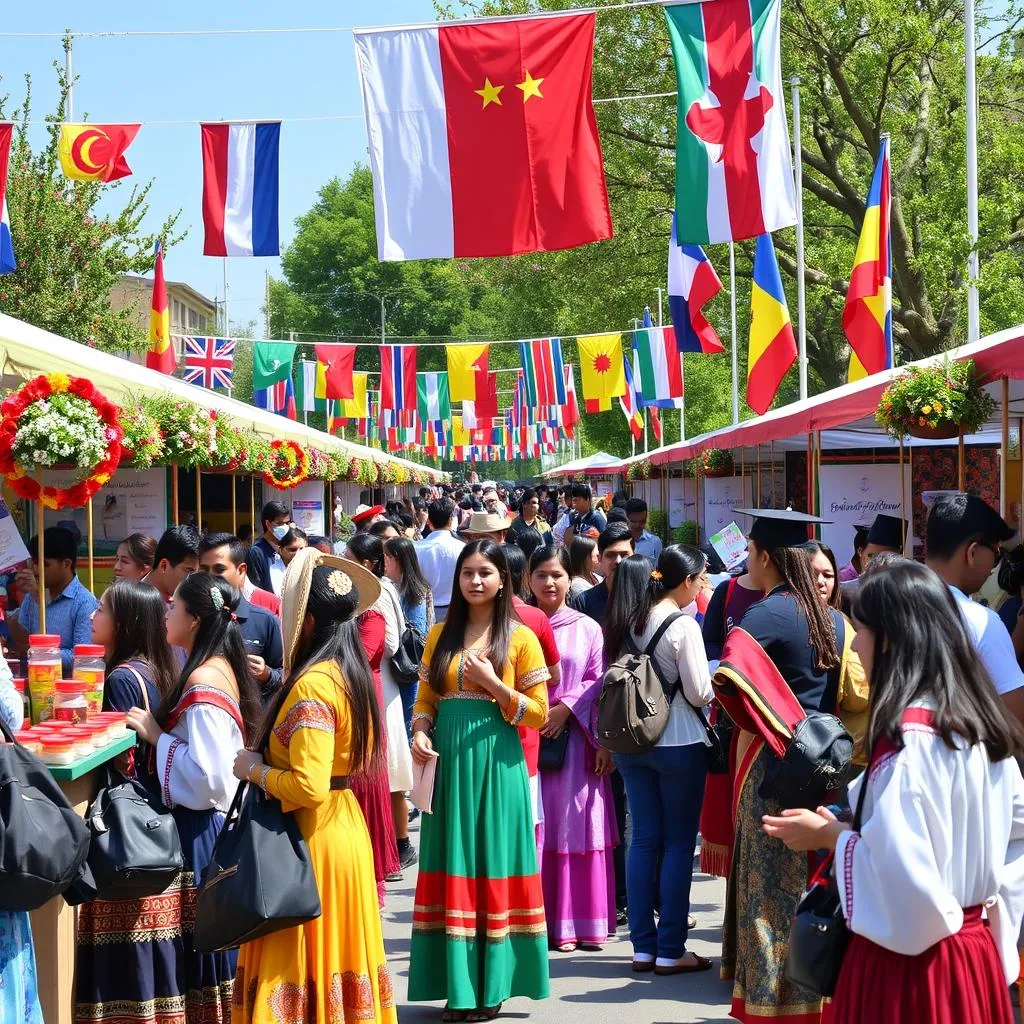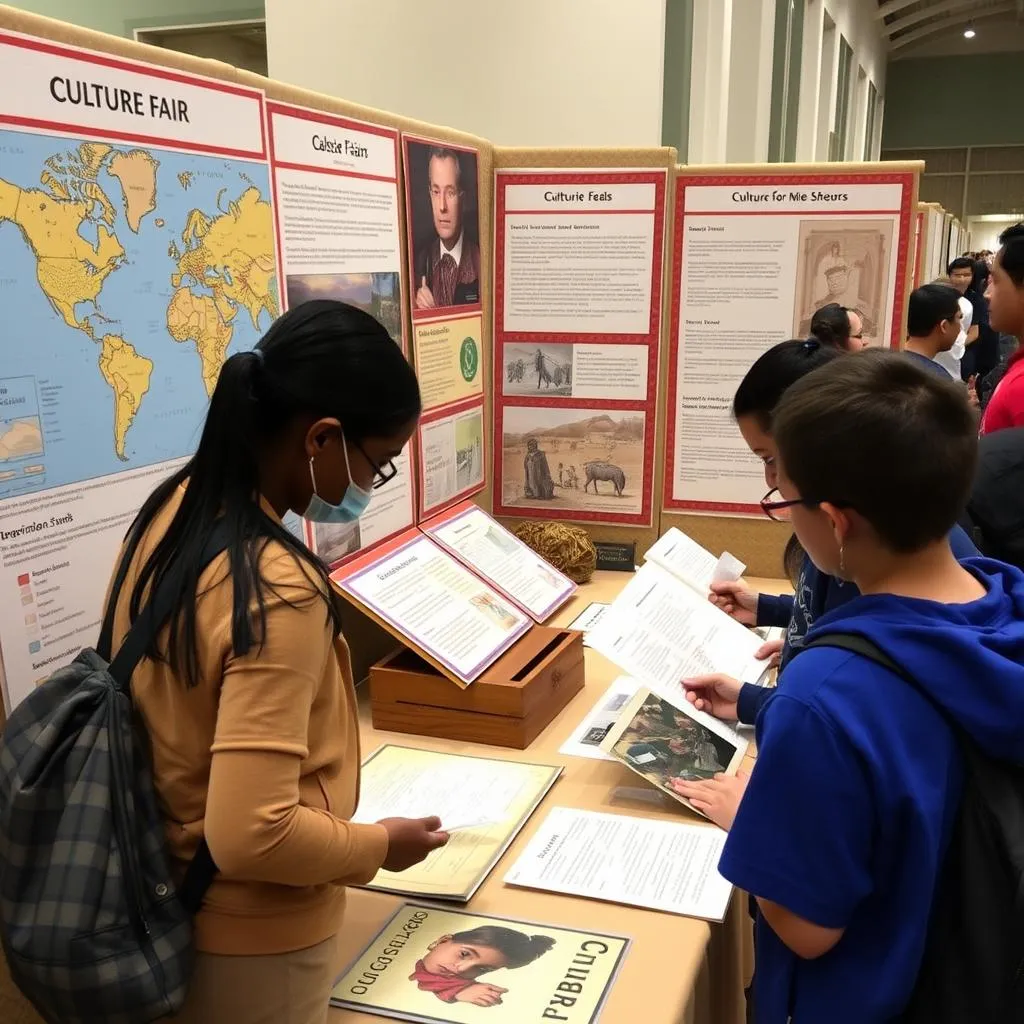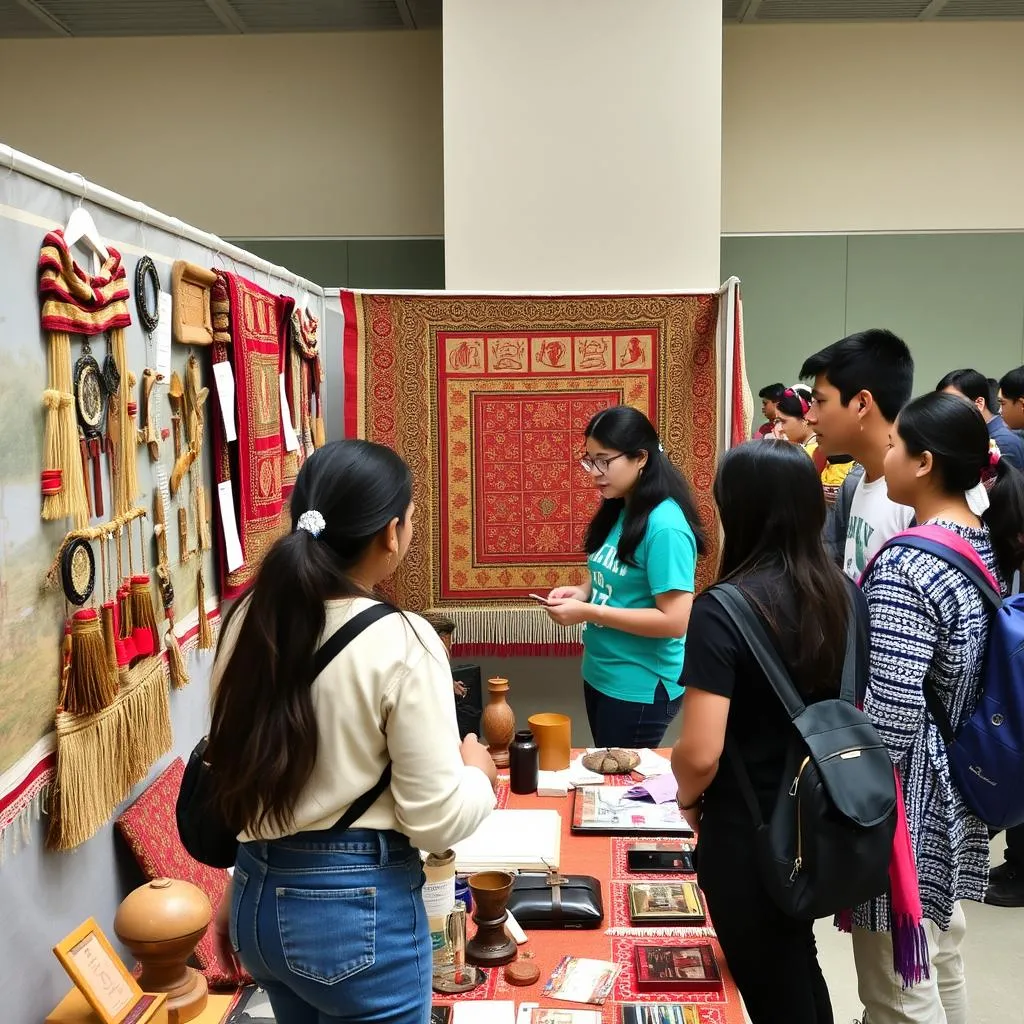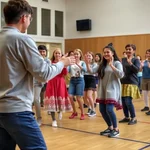The role of cultural fairs in promoting student understanding is a fascinating topic that often appears in IELTS Reading tests. Let’s dive into a comprehensive practice test that will help you sharpen your skills and expand your knowledge on this subject.
Passage 1 – Easy Text
The Impact of Cultural Fairs on Campus Life
Cultural fairs have become an integral part of many university campuses worldwide, serving as vibrant platforms for students to showcase and celebrate diversity. These events play a crucial role in fostering cross-cultural understanding and appreciation among the student body. By immersing themselves in various cultural experiences, students can broaden their perspectives and develop a more nuanced view of the world.
The role of student-led initiatives in promoting cultural events is particularly significant in the success of these fairs. Student organizers often bring fresh ideas and enthusiasm to the planning process, ensuring that the events resonate with their peers. This hands-on involvement not only enhances the quality of the fairs but also provides valuable leadership and organizational skills to the students themselves.
One of the primary benefits of cultural fairs is the opportunity they provide for intercultural dialogue. Students from different backgrounds can engage in meaningful conversations, share their traditions, and learn from one another in a relaxed and festive atmosphere. This exchange of ideas and experiences can lead to long-lasting friendships and a more inclusive campus environment.
Moreover, cultural fairs often feature traditional cuisine, music, dance, and art from various countries and regions. This multisensory experience allows participants to gain a deeper appreciation for the richness and diversity of global cultures. By tasting new foods, listening to unfamiliar melodies, and observing intricate artistic creations, students can develop a more profound respect for cultural differences and similarities.
 Students participating in a vibrant cultural fair
Students participating in a vibrant cultural fair
Questions 1-5
Do the following statements agree with the information given in the passage? Write
TRUE if the statement agrees with the information
FALSE if the statement contradicts the information
NOT GIVEN if there is no information on this
- Cultural fairs are becoming less common on university campuses.
- Student-led initiatives play an important role in organizing cultural fairs.
- Cultural fairs can help students develop leadership skills.
- All students are required to participate in cultural fairs.
- Cultural fairs often include food and music from different countries.
Questions 6-10
Complete the sentences below. Choose NO MORE THAN TWO WORDS from the passage for each answer.
- Cultural fairs provide a platform for students to showcase and celebrate ____.
- By participating in cultural fairs, students can develop a more ____ view of the world.
- Cultural fairs create opportunities for ____ dialogue between students from different backgrounds.
- The ____ experience of cultural fairs allows participants to gain a deeper appreciation for global cultures.
- Through cultural fairs, students can develop a profound respect for cultural ____ and similarities.
Passage 2 – Medium Text
The Educational Value of Cultural Fairs
While cultural fairs are often seen as entertaining events, their educational value should not be underestimated. These vibrant gatherings serve as informal learning environments where students can acquire knowledge about diverse cultures in a way that complements their formal academic studies. The experiential nature of cultural fairs makes them particularly effective in promoting student understanding and retention of cultural information.
One of the key educational benefits of cultural fairs is the development of cultural competence. As students interact with peers from different backgrounds and engage with various cultural displays, they begin to cultivate a set of skills, knowledge, and attitudes that enable them to function effectively in diverse settings. This cultural competence is increasingly valued in today’s globalized world, where the ability to navigate cultural differences is essential in many professional and personal contexts.
The role of universities in promoting global cultural dialogue is significantly enhanced through cultural fairs. These events provide a tangible platform for institutions to demonstrate their commitment to diversity and inclusion. By supporting and facilitating cultural fairs, universities create opportunities for students to engage in meaningful cross-cultural exchanges that can have lasting impacts on their worldviews and future interactions.
Furthermore, cultural fairs can serve as catalysts for more in-depth exploration of global issues. The exposure to different cultures often sparks curiosity among students, encouraging them to delve deeper into topics such as international relations, global economics, and comparative cultural studies. This intellectual stimulation can lead to increased enrollment in related courses and a greater interest in study abroad programs.
 Educational display at a cultural fair
Educational display at a cultural fair
The impact of cultural fairs extends beyond the event itself. Many students report that their experiences at these fairs have influenced their career choices, leading them to pursue international business, diplomacy, or cross-cultural communication. The networking opportunities provided by cultural fairs can also be invaluable, allowing students to make connections that may benefit them in their future academic and professional endeavors.
It is important to note that the educational value of cultural fairs is not limited to international or multicultural students. Domestic students often gain just as much, if not more, from these events, as they may have fewer opportunities for direct cross-cultural experiences in their daily lives. Cultural fairs can help break down stereotypes and preconceptions, fostering a more inclusive and understanding campus community.
Questions 11-14
Choose the correct letter, A, B, C, or D.
-
According to the passage, cultural fairs are effective in promoting student understanding because:
A) They are mandatory for all students
B) They are more formal than regular classes
C) They provide experiential learning opportunities
D) They are graded events -
The development of cultural competence through cultural fairs is important because:
A) It is a requirement for graduation
B) It helps students function effectively in diverse settings
C) It guarantees job placement after graduation
D) It is only valuable for international students -
Universities support cultural fairs because:
A) They generate revenue for the institution
B) They replace traditional classroom learning
C) They demonstrate commitment to diversity and inclusion
D) They are required by law -
The passage suggests that cultural fairs can lead to:
A) Decreased interest in global issues
B) Increased enrollment in culture-related courses
C) Lower participation in study abroad programs
D) Reduced interaction among students
Questions 15-19
Complete the summary below. Choose NO MORE THAN TWO WORDS from the passage for each answer.
Cultural fairs provide an (15) ____ learning environment that complements formal academic studies. They help students develop (16) ____, which is valuable in today’s globalized world. Universities use these events to promote (17) ____ and create opportunities for cross-cultural exchanges. The fairs often spark (18) ____ among students, leading to deeper exploration of global issues. Many students report that cultural fairs have influenced their (19) ____, particularly in fields related to international affairs.
Passage 3 – Hard Text
The Multifaceted Impact of Cultural Fairs on Student Development
The proliferation of cultural fairs in educational institutions has garnered significant attention from researchers and educators alike, owing to their profound impact on student development. These events, far from being mere social gatherings, serve as potent catalysts for personal growth, intercultural competence, and global awareness among participants. The multifaceted nature of cultural fairs contributes to their effectiveness in fostering a range of skills and attitudes that are increasingly crucial in our interconnected world.
One of the most salient benefits of cultural fairs is their role in cultivating empathy and perspective-taking abilities among students. Through immersive experiences and direct interactions with diverse cultural representations, participants are compelled to step outside their own cultural frameworks and consider alternative worldviews. This process of cognitive decentering is instrumental in developing the capacity for empathy, which is fundamental to effective cross-cultural communication and collaboration.
Moreover, cultural fairs serve as microcosms of global society, providing students with a simulated environment in which to practice and refine their intercultural skills. The negotiation of cultural differences, whether in communication styles, social norms, or value systems, that occurs during these events can significantly enhance students’ cultural intelligence (CQ). This form of intelligence, which encompasses the ability to function effectively in culturally diverse settings, is increasingly recognized as a critical competency in both academic and professional spheres.
The rise of cultural diplomacy through educational exchanges has further underscored the importance of events like cultural fairs. These fairs often serve as informal platforms for cultural diplomacy at the grassroots level, allowing students to engage in people-to-people exchanges that can foster mutual understanding and goodwill across national and cultural boundaries. The ripple effects of these interactions can extend far beyond the immediate context of the fair, potentially influencing broader societal attitudes towards cultural diversity and international cooperation.
 International student collaboration at a cultural fair
International student collaboration at a cultural fair
The cognitive benefits of participating in cultural fairs are equally noteworthy. Exposure to diverse cultural stimuli has been shown to enhance cognitive flexibility and creative thinking. The juxtaposition of different cultural elements often challenges students’ existing mental schemas, prompting them to engage in more complex and nuanced thinking. This cognitive stretching can lead to improved problem-solving skills and a greater capacity for innovation, attributes that are highly valued in today’s knowledge-based economy.
Furthermore, cultural fairs can play a significant role in identity formation and self-reflection among students. For many participants, particularly those from minority or immigrant backgrounds, these events provide a rare opportunity to showcase and celebrate their cultural heritage within the broader academic community. This validation of cultural identity can boost self-esteem and foster a stronger sense of belonging within the institution. Conversely, for students from the majority culture, cultural fairs can prompt critical reflection on their own cultural assumptions and biases, leading to a more nuanced understanding of their place in a multicultural society.
It is important to note, however, that the effectiveness of cultural fairs in promoting student understanding is contingent upon thoughtful design and implementation. Mere exposure to cultural diversity does not automatically translate into increased intercultural competence or global awareness. Cultural differences in educational leadership styles can significantly impact the approach to organizing and facilitating these events. Therefore, it is crucial for organizers to incorporate structured reflection and guided discussion into the fair experience, enabling students to process and internalize their learnings effectively.
In conclusion, the role of cultural fairs in promoting student understanding is multifaceted and profound. These events serve as powerful tools for developing empathy, enhancing cultural intelligence, fostering cognitive flexibility, and supporting identity formation. As educational institutions continue to grapple with the challenges of preparing students for an increasingly globalized world, cultural fairs stand out as invaluable opportunities for experiential learning and intercultural engagement. By providing a dynamic and immersive environment for cultural exchange, these fairs contribute significantly to the development of globally competent and culturally sensitive individuals.
Questions 20-23
Choose the correct letter, A, B, C, or D.
-
According to the passage, cultural fairs are effective in promoting student development because:
A) They are mandatory events for all students
B) They focus solely on academic achievements
C) They provide diverse experiences and interactions
D) They are graded components of the curriculum -
The process of ‘cognitive decentering’ mentioned in the passage refers to:
A) Forgetting one’s own cultural background
B) Considering alternative worldviews
C) Rejecting all cultural differences
D) Focusing only on one’s own culture -
Cultural intelligence (CQ) is described in the passage as:
A) The ability to speak multiple languages
B) Knowledge of global history
C) The capacity to function effectively in diverse cultural settings
D) Expertise in international cuisine -
The cognitive benefits of participating in cultural fairs include:
A) Memorizing facts about different cultures
B) Enhancing cognitive flexibility and creative thinking
C) Improving mathematical skills
D) Increasing reading speed
Questions 24-26
Complete the sentences below. Choose NO MORE THAN TWO WORDS from the passage for each answer.
- Cultural fairs often challenge students’ existing ____, leading to more complex thinking.
- For students from minority backgrounds, cultural fairs can provide validation of their ____.
- The effectiveness of cultural fairs depends on thoughtful ____ and implementation.
Questions 27-30
Do the following statements agree with the claims of the writer in the passage? Write
YES if the statement agrees with the claims of the writer
NO if the statement contradicts the claims of the writer
NOT GIVEN if it is impossible to say what the writer thinks about this
- Cultural fairs always result in increased intercultural competence for all participants.
- Structured reflection and guided discussion are important components of effective cultural fairs.
- Cultural fairs are more beneficial for international students than for domestic students.
- The impact of cultural fairs on student development has been extensively studied by researchers.
Answer Key
Passage 1
- FALSE
- TRUE
- TRUE
- NOT GIVEN
- TRUE
- diversity
- nuanced
- intercultural
- multisensory
- differences
Passage 2
- C
- B
- C
- B
- informal
- cultural competence
- global cultural dialogue
- curiosity
- career choices
Passage 3
- C
- B
- C
- B
- mental schemas
- cultural identity
- design
- NO
- YES
- NOT GIVEN
- YES
The influence of religious education on cultural perspectives is another important aspect to consider when exploring the broader impact of cultural education on student understanding. While not directly addressed in this practice test, it’s a topic that often intersects with cultural fairs and global awareness initiatives in educational settings.


